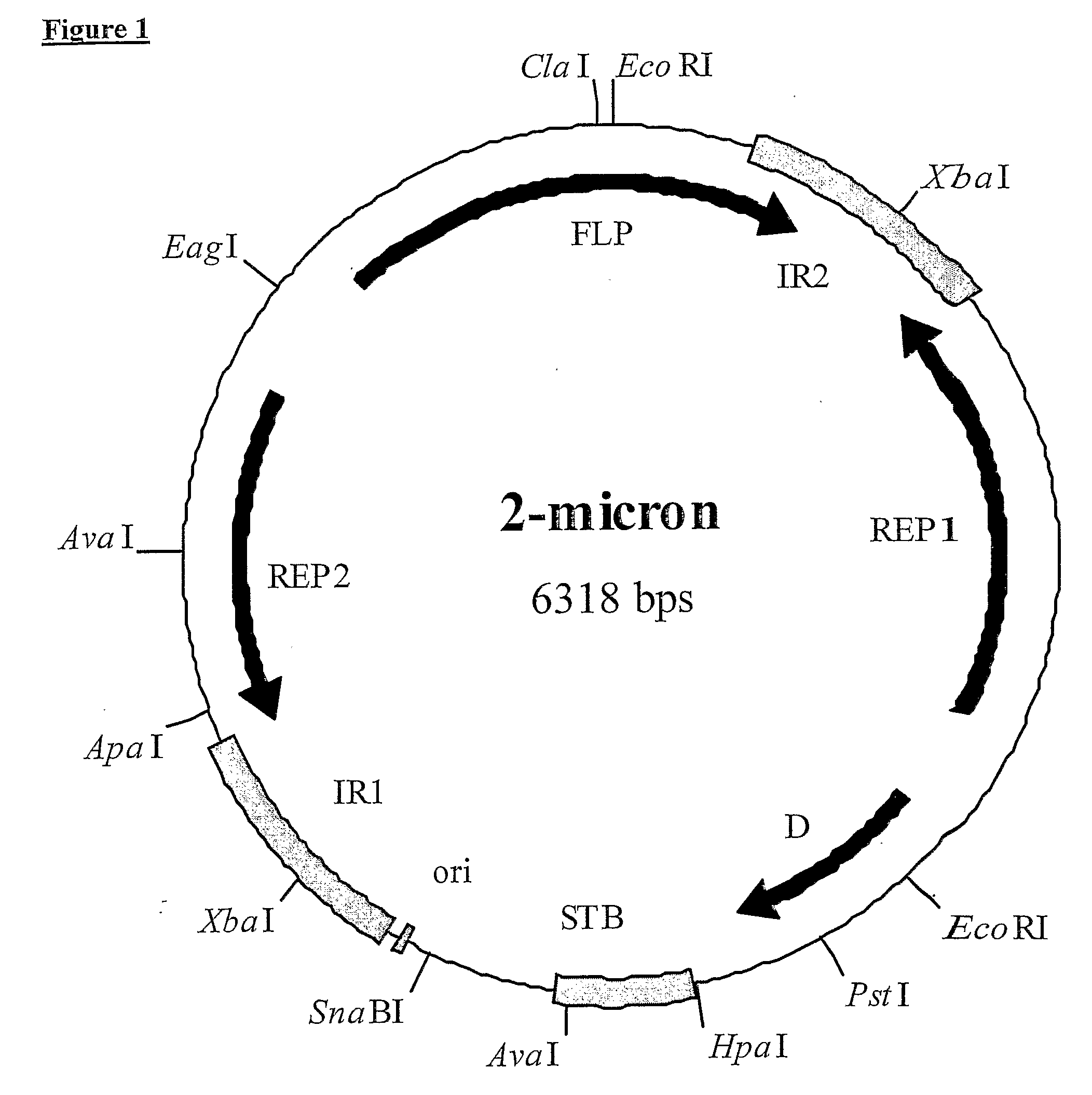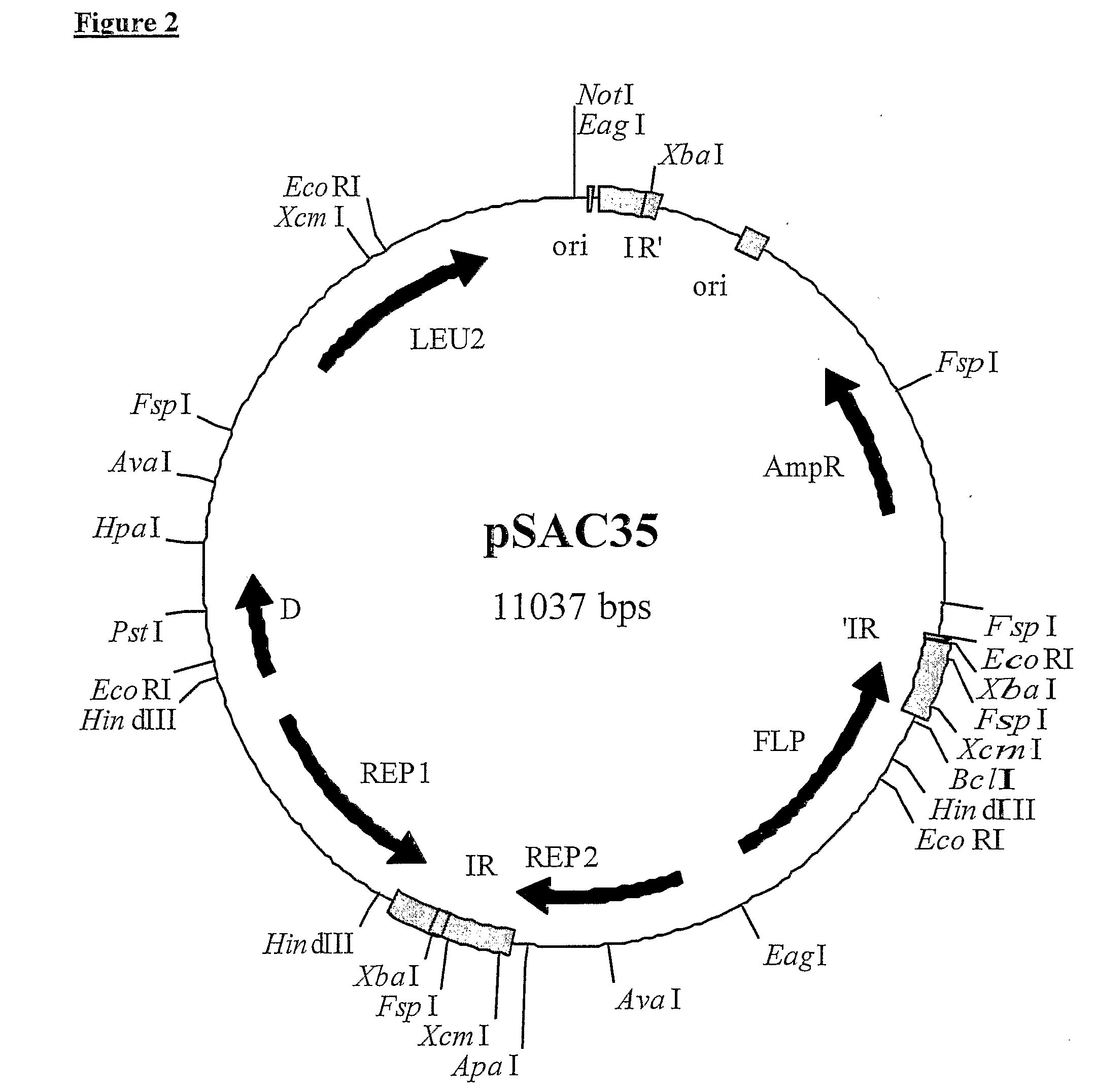2-Micron Family Plasmid and Use Thereof
- Summary
- Abstract
- Description
- Claims
- Application Information
AI Technical Summary
Benefits of technology
Problems solved by technology
Method used
Image
Examples
example 1
Insertion of Synthetic DNA Linker into XcmI-Sites in the Small Unique Region of pSAC35
[0258]Sites assessed initially for insertion of additional DNA into the US-region of pSAC35, were the XcmI-sites in the 599-bp inverted repeats. One XcmI-site cuts 51-bp after the REP2 translation termination codon, whereas the other XcmI-site cuts 127-bp before the end of the FLP coding sequence, due to overlap with the inverted repeat (see FIG. 3).
[0259]The sequence inserted was a 52-bp linker made by annealing 0.5 mM solutions of oligonucleotides CF86 and CF87. This DNA linker contained a core region “SnaBI-PacI-FseI / SfiI-SmaI-SnaBI”, which encoded restriction sites absent from pSAC35.
[0260]Plasmid pSAC35 was partially digested with XcmI, the linear 11-kb fragment was isolated from a 0.7% (w / v) agarose gel, ligated with the CF86 / CF87 XcmI linker (neat, 10−1 and 10−2 dilutions) and transformed into E. coli DH5α. Ampicillin resistant transformants were selected and screened for the presence of pla...
example 2
Insertion of the PDI1 Gene into the XcmI Linker of pDB2688
[0272]The insertion of a large DNA fragment into the US-region of 2 μm-like vectors was demonstrated by cloning the S. cerevisiae PDI1 gene into the XcmI-linker of pDB2688. The PDI1 gene (FIG. 9) was cloned on a 1.9-kb SacI-SpeI fragment from a larger S. cerevisiae SKQ2n genomic DNA fragment containing the PDI1 gene (as provided in the plasmid pMA3a:C7 that is described in U.S. Pat. No. 6,291,205 and also described as Clone C7 in Crouzet & Tuite, 1987, Mol. Gen. Genet., 210, 581-583 and Farquhar et al, 1991, supra), which had been cloned into YIplac211 (Gietz & Sugino, 1988, Gene, 74, 527-534) and had a synthetic DNA linker containing a SacI restriction site inserted at a unique Bsu36I-site in the 3′ untranslated region of the PDI1 gene. The 1.9-kb SacI-SpeI fragment was treated with T4 DNA polymerase to fill the SpeI 5′-overhang and remove the SacI 3′-overhang. This PDI1 fragment included 212-bp of the PDI1 promoter upstream...
example 3
Insertion of DNA Linkers into the REP2 Gene and Downstream Sequences in the Inverted Repeat of pSAC35
[0278]To define the useful limits for insertion of additional DNA into the REP2 gene and sequences in the inverted repeat downstream of it, further linkers were inserted into pSAC35. FIG. 12 indicates the restriction sites used for these insertions and the effects on the Rep2 protein of translation termination at these sites.
[0279]The linker inserted at the XmnI-site in REP2 was a 44-bp sequence made from oligonucleotides CF108 and CF109.
[0280]To avoid insertion into other XmnI-sites in pSAC35, the 3,076-bp XbaI fragment from pSAC35 that contained the REP2 and FLP genes was first sub-cloned into the E. coli cloning vector pDB2685 (FIG. 13) to produce pDB2783 (FIG. 14).
[0281]Plasmid pDB2685 is a pUC18-like cloning vector derived from pCF17 containing apramycin resistance gene aac(3)IV from Klebsiella pneumoniae (Rao et al, 1983, Antimicrob. Agents Chemother., 24, 689) and multiple clo...
PUM
| Property | Measurement | Unit |
|---|---|---|
| Length | aaaaa | aaaaa |
| Fraction | aaaaa | aaaaa |
| Fraction | aaaaa | aaaaa |
Abstract
Description
Claims
Application Information
 Login to View More
Login to View More - R&D
- Intellectual Property
- Life Sciences
- Materials
- Tech Scout
- Unparalleled Data Quality
- Higher Quality Content
- 60% Fewer Hallucinations
Browse by: Latest US Patents, China's latest patents, Technical Efficacy Thesaurus, Application Domain, Technology Topic, Popular Technical Reports.
© 2025 PatSnap. All rights reserved.Legal|Privacy policy|Modern Slavery Act Transparency Statement|Sitemap|About US| Contact US: help@patsnap.com



